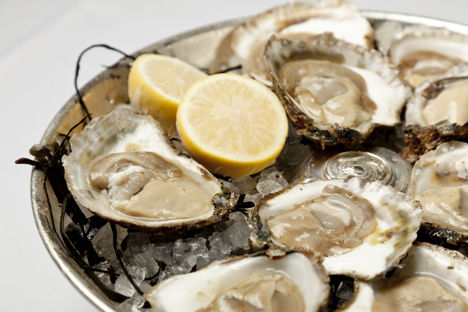
Ingredient focus: oysters
Ingredient focus: oysters
The month of September sees the return of native oysters to restaurants and fishmongers up and down the country. The UK’s original species spawn from the end of April until the end of August, hence the saying oysters should only be eaten in months with an ‘R’ in the name.
Oysters have been eaten in the UK since they were popularised by the Romans and continued to be popular until the early 1900s when, due to pollution and overfishing, oysters were drastically reduced in numbers. It was around this time that oysters were introduced from the US; Pacific or ‘rock’ oysters could be grown in 2 years in comparison to the 4 years in which it takes to grow a native oyster and, as they are able to spawn at lower temperatures, they can be eaten all year round.
Flavour profile
The taste of oysters varies greatly depending on where they are grown, and as there are fisheries all over the UK, this means that we can try over fourteen types of the same species of oyster and compare the flavours. In different oysters we can measure the sweetness, saltiness and overall tasting notes. When cooked, a new flavour profile is released in the oyster, allowing it to become rich and creamy.
Some people detect cut grass and avocados in oysters along with astringency and acidity. The main aroma from an oyster is of a green, grassy, cucumber-like smell. As with any seafood, fresh is best and the flavour of oysters is better the fresher they are.
Food matches
Oysters are traditionally eaten raw with little more than a squeeze of lemon, a dash of Tabasco or spoonful of mignonette sauce. The acidity offsetting the saltiness of the oyster.
Delicate, aromatic herbs such as dill, parsley and thyme pair beautifully with oyster; the green aromas complement each other well, as does cucumber. Perhaps try a simple yet elegant canapé recipe using these flavours, such as this Oyster, daikon, cucumber and buttermilk recipe. Coconut also shares these green aromas, such as in this Oysters with coconut and lychee canapé.
Oysters also lend themselves well to Asian flavours, such as soy, ginger, chilli and garlic. As Richard Corrigan says, 'Oyster sauce isn’t an accident'.
Oysters are delicious deep-fried and make a great canapé served with a chilled glass of champagne.
White wine, champagne and beer all make great accompaniments to oysters: Guinness especially is a firm favourite of many but is not to everyone’s taste. Steer away from spirits when eating raw oysters, as the combination can have upsetting consequences on digestion, which is often mistaken for food poisoning.
Did you know?
Oysters gram for gram contain eight times more iron than chicken.
In the 17th century it was commonplace to make sausages from oysters and mutton, and oysters were often used as a substitute for meat in pies.
A single oyster filters up to 6 litres of water per day.


